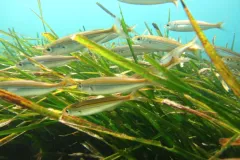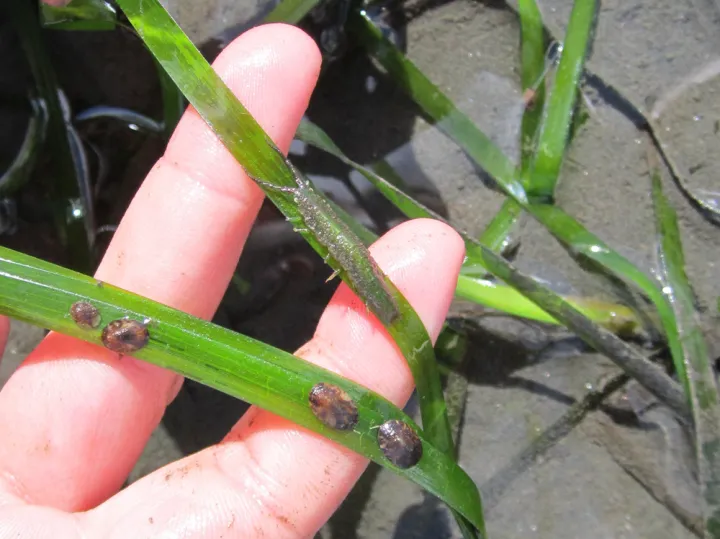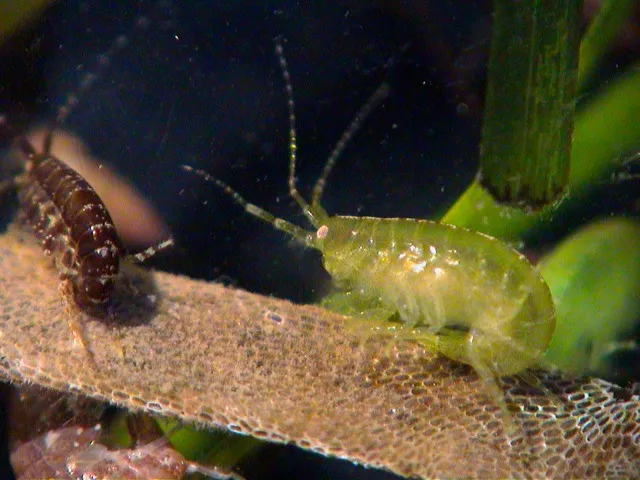Bugs and Slugs: The Hidden Secret to Healthy Seagrasses

Slip into the water along a sheltered coast in nearly any part of the world and you’re likely to find yourself in an emerald field of seagrass. Like flowering plants on land, seagrasses grow, flower, and produce seeds—and they do it all underwater. Although they may lack the star power of coral reefs, seagrass meadows can be equally beautiful, teeming with a diversity of life, and are every bit as important as reefs. Seagrass meadows are nurseries for young fishes, feeding grounds for sea turtles, manatees and birds, and their extensive root systems bind sediments to protect coasts. In fact, one pioneering study found that seagrass beds are among the most valuable habitats in the world by protecting coastlines and soaking up excess nutrients that runoff the land.
The queen of seagrasses, as it were, is the somewhat inelegantly named eelgrass (Zostera marina). Eelgrass forms luxurious meadows in shallow water along estuaries and coasts throughout the Northern Hemisphere, from Baja California and Portugal in the south all the way to Alaska and the Russian White Sea in the north.
You might think that a plant that can survive underwater and has conquered such an expansive territory would be invincible. Sadly, this is far from the case. Eelgrass, like many other seagrass species, is in decline throughout the world. The reasons are many but a main suspect is pollution. Excess nutrients from agricultural fertilizers stimulate the growth of algae, which can quickly overwhelm the comparatively slow-growing seagrasses and smother them.
But eelgrass has an unlikely accomplice in its battle against algae: an army of grazing critters. Its dense shoots and blades provide ideal habitat for a host of small animals like crustaceans, snails, and worms that preferentially feed on algae. It's a really neat partnership (or mutualism) where the seagrass provides a home for these grazers, and the grazers in turn gobble up the algae and keep the seagrass clean and healthy.
Unfortunately for seagrass, fishing can disrupt this grazing partnership. When predators are removed by fishing, the effects can cascade all the way down the food chain to alter the populations of algae-eating animals. With the grazers gone (or significantly disturbed), algae can grow wild and hurt or even kill the seagrasses.
Here we have two separate threats—pollution and fishing—that both cause algae growth on seagrass beds. But which is a more important human impact? Some researchers have found evidence in the lab that pollution is the main driver, while others have found that the loss of grazers from fishing has a stronger effect on algae growth. We just published the results of the largest experiment on seagrass beds to find the answer to this question: Are bugs and slugs the hidden secret to healthy seagrasses, or are they just lawn ornaments?
Because eelgrass grows in many different places with wide variation in environmental factors (like temperature and salinity) and biology (like how many and what kinds of species are present), we needed to study many locations at once to draw any broad conclusions. To tackle this large experiment, we enlisted the help of colleagues throughout the world to conduct an identical experiment at 15 seagrass sites during the same season. The result was the Zostera Experimental Network or ZEN (www.ZENscience.org), a unique collaboration of marine biologists that has now grown to include 50 sites worldwide with partners from 24 institutions in 14 countries.
In our experiment, we did two things. First, we heavily fertilized the seagrass similarly to how you might fertilize your lawn to simulate nutrient pollution. Next, we applied a dilute pesticide to drive away small crustacean grazers, which simulated changes in the food web from fishing. The results of this experiment, unsurprisingly, differed considerably among the 15 different field sites. But we did find something really surprising: on average, taking away small grazers caused a proliferation of algae, but fertilization had little effect. Although we know nutrient pollution can damages seagrasses in many places, the new results show that bugs and slugs are the hidden secret to healthy eelgrass!
Another exciting result was that more biodiverse grazer communities were better able to keep the eelgrass clean. Specifically, sites with more species of algae-eating invertebrates had less algae compared to sites where only a few species of grazers were present. And this biodiversity effect on algae was stronger than the effects of other environmental parameters like temperature in addition to our experimental fertilization. The new results from across our ZEN sites provide an exciting, and rare large-scale confirmation of the importance of biodiversity to healthy ecosystems.
At least as important as the scientific results is the team science model we've forged to tackle big and difficult question in environmental science. By working together across borders, continents and disciplines, we can get beyond our own backyard and strive to achieve better, more useful science to inform policy, management and conservation.



